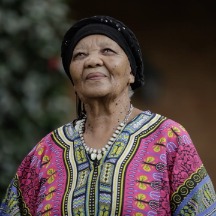Early Years and Family Life
Katrina Esau was born in 1933 on Farm Klapien in Olifantshoek, Upington, Northern Cape Province. They were a family of eight sisters and three brothers.
Esau’s father was a Motswana and her mother a Khoisan. They were farm workers and all their children were born and brought up on this farm. While they were growing up on the farm, the farmer did not allow them to speak their native language, Nluu. Esau recalls the farmer telling them that their language sounded horrible and ugly and should never be spoken around White children on the farm.
The Nluu language was the only language that Queen Katrina, as she is sometimes called, and her siblings understood and knew. It was their mother tongue. They tried to protest, but the farmer threatened to shoot them if they were caught speaking the language. Many Khoi people stopped speaking their Nluu language; they knew the farmer’s threats were not empty threats.
Esau believes this contributed to the language’s subsequent disappearance. It was already a minority language. But Esau and her siblings always found a way to defy the farmer and continued to speak in their language whenever they could.
Esau’s mother taught her children to speak Afrikaans to prepare them for jobs on the farm when they were old enough to work. All the Khoisan children living on the farm were not allowed to go to school. As children of farm workers, they were expected to work on farms like their parents. Esau never went to school and she started working on Farm Koeipan, the same farm which employed her parents, at age 16.
She was then called Geelmeid her whole childhood and the name stuck and is still used to this day. “Geel” means yellow in Afrikaans and “meid” means maid, Yellowmaid.
Queen Katrina says when she was born she was yellow in colour, as are most Khoisan babies. When the farmer learned what the baby’s name was, he was angry that he she was given a proper name for “proper” children. He said this to Esau ’s mother as per the recollection of Esau ’s memory when her mother told her this.
“Katrina for what? Don’t you see how yellow this baby is? We’ll call her Geelmeid!” She was then called Geelmeid her whole childhood and the name stuck and is still used to this day. “Geel” means yellow in Afrikaans and “meid” means maid, Yellowmaid.
Growing up Khoisan
Esau says their knowledge of the land, trees, and herbs is what the Khoisan people pride themselves in. They know which plants are deadly and which are edible and healing.As is the history of the Khoi people, they used creative ways for survival. For example, after a hard day in the veld (field) hunting Springboks, a medium-sized antelope found mainly in southern and southwestern Africa, one of the first things the hunters would do after that hard kill was to take out the Springbok’s stomach and press it hard until water came out. They would drink the water to quench their thirst.







